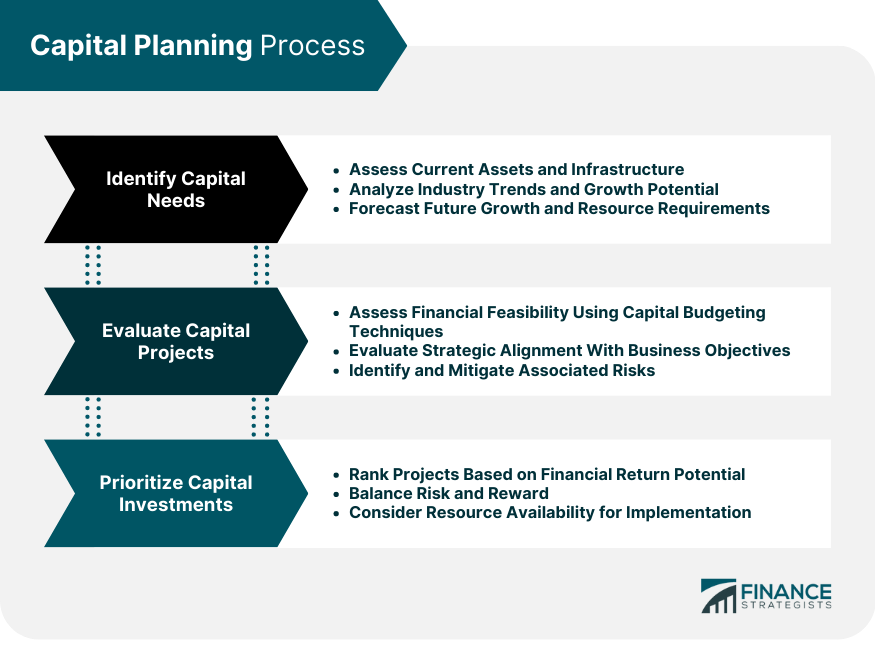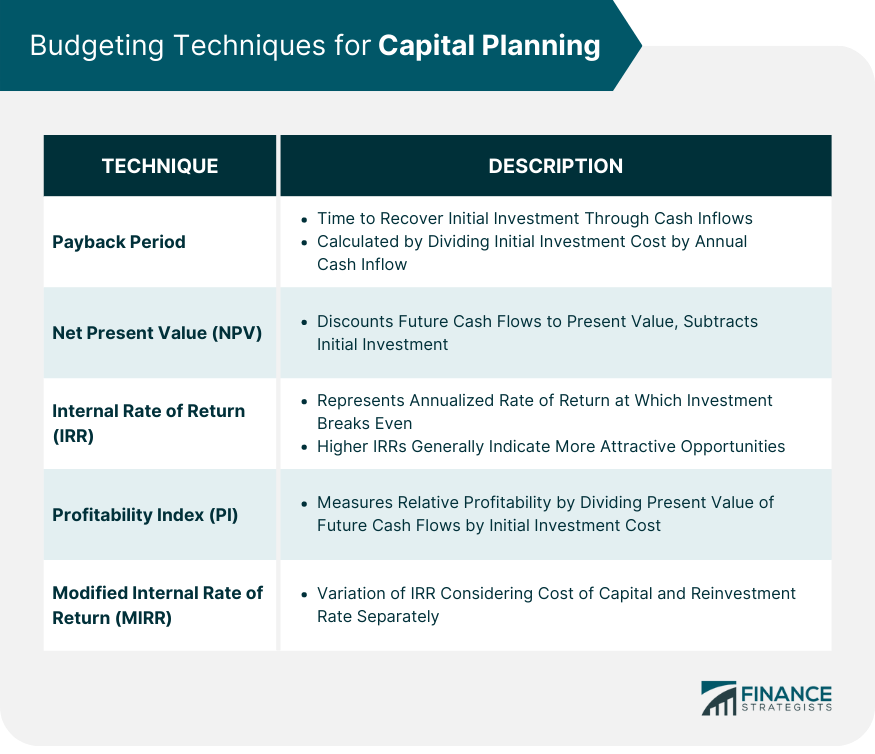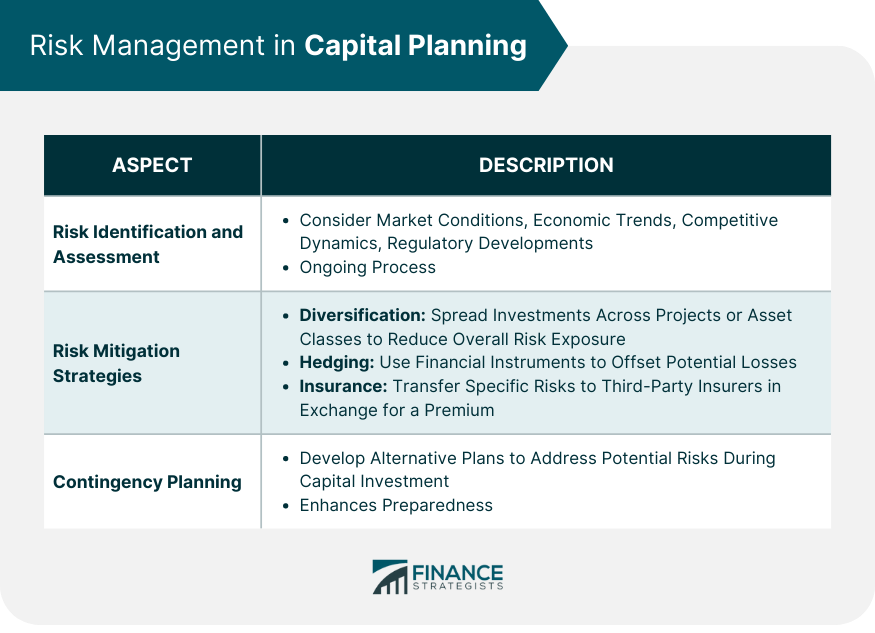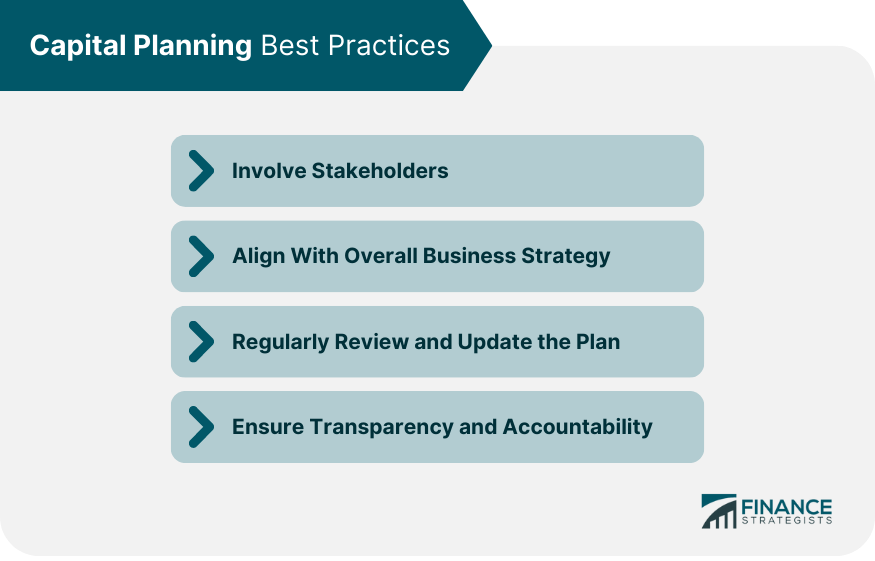Capital planning is a critical process that businesses undertake to allocate financial resources to long-term investments and projects, such as acquiring new equipment, launching new products, or expanding operations. The primary aim of capital planning is to ensure that a company's investments generate the highest possible return, contribute to its long-term growth and success, and minimize financial risks. A well-designed capital plan can help a company identify the most beneficial investment opportunities, create a balanced portfolio of projects, and allocate resources strategically. Effective capital planning is crucial for a business's long-term success and financial stability. It allows organizations to make strategic decisions about where to invest resources to achieve their growth objectives, maximize shareholder value, and maintain a competitive edge in the marketplace. By carefully evaluating potential investments, companies can ensure that they are putting their money into projects that align with their overall strategy and have the potential to deliver significant returns. Furthermore, capital planning helps businesses minimize investment risks by identifying potential threats and developing strategies to mitigate them. This step involves assessing a company’s current assets, forecasting future growth, and analyzing industry trends. It includes evaluating the organization's existing infrastructure, equipment, and technology to determine if they are adequate to meet its short and long-term objectives. Additionally, companies should assess their growth potential by analyzing market trends, customer demand, and competition to identify areas where investment may be required. Forecasting future growth is critical to identifying capital needs, as it provides valuable insights into the company's potential revenue streams and resource requirements. Companies should utilize historical data, market research, and industry analysis to create accurate growth projections. Understanding industry trends is essential for identifying opportunities for investment and potential challenges that may impact the organization's financial performance. Evaluating a company’s potential capital projects is done to determine their financial feasibility, strategic alignment, and associated risks. Financial feasibility refers to the project's ability to generate a return on investment (ROI) that exceeds its cost of capital. This can be assessed using various capital budgeting techniques, such as net present value (NPV), internal rate of return (IRR), and payback period. Strategic alignment is essential in the evaluation process, as it ensures that the proposed project aligns with the company's overall business strategy and objectives. This may involve analyzing the project's potential impact on market share, competitive positioning, and long-term growth potential. Risk assessment is another critical aspect of project evaluation, as it involves identifying potential risks associated with the investment and developing strategies to mitigate them. This involves ranking projects according to their potential for financial return, considering factors such as projected cash flows, payback period, and NPV. Balancing risk and reward is also a critical aspect of prioritizing investments. Companies should aim to create a balanced portfolio of projects that offers an optimal mix of potential returns and risk exposure. Resource availability is another important factor to consider when prioritizing capital investments. Companies must ensure they have the financial, human, and technological resources to support the successful implementation of their chosen projects. This may require reallocating resources from other business areas or seeking external financing to fund the investment. The payback period is a simple capital budgeting technique that calculates the amount of time it takes for an investment to recoup its initial cost through cash inflows. It is calculated by dividing the initial investment cost by the annual cash inflow generated by the project. The payback period is useful for comparing investment options with similar risk profiles, as it provides a straightforward measure of how quickly an investment will start generating positive returns. However, the payback period must account for the time value of money or cash flows generated after the initial investment has been recouped, which may limit its usefulness in evaluating long-term projects. NPV is a more sophisticated capital budgeting technique that accounts for the time value of money by discounting future cash flows to their present value. The NPV is calculated by subtracting the present value of cash outflows (initial investment) from the present value of cash inflows generated by the project over its life. A positive NPV indicates that the project is expected to generate a return greater than the cost of capital, making it a potentially worthwhile investment. In contrast, a negative NPV suggests that the project's returns are unlikely to cover its costs. NPV is widely used by businesses to compare investment opportunities and determine their financial viability. The IRR calculates the discount rate at which the net present value of a project's cash flows becomes zero. In other words, the IRR represents the annualized rate of return at which the investment breaks even. The IRR can be used to compare the profitability of different investment options, with higher IRRs generally indicating more attractive opportunities. It is important to note that the IRR assumes that all future cash flows are reinvested at the same rate, which may only sometimes be the case in practice. The profitability index measures the relative profitability of an investment by dividing the present value of its future cash flows by the initial investment cost. A PI greater than 1 indicates that the project is expected to generate a positive net present value. In contrast, a PI of less than 1 suggests that the investment may not be financially viable. The PI is useful for comparing the relative profitability of different investment options, as it takes into account both the size of the investment and the potential returns. The modified internal rate of return (MIRR) is a variation of the IRR that addresses some of its limitations by considering the cost of capital and the reinvestment rate of cash flows separately. The MIRR calculates the annualized rate of return at which the present value of a project's cash inflows, discounted at the reinvestment rate, equals the present value of its cash outflows, discounted at the cost of capital. The MIRR provides a more realistic measure of a project's profitability, accounting for the actual reinvestment opportunities available to the company. Risk management is a critical aspect of capital planning, as it helps businesses identify and assess potential risks associated with their investments. This involves analyzing various factors, such as market conditions, economic trends, competitive dynamics, and regulatory developments, to determine the likelihood and potential impact of various risks on the company's financial performance. Risk assessment should be an ongoing process, as new risks may emerge over time, or existing risks may change in magnitude or probability. Once risks have been identified and assessed, businesses should develop strategies to mitigate their potential impact on capital investments. This can involve a range of approaches, such as diversification, hedging, and insurance. Diversification is spreading investments across a range of projects or asset classes to reduce the portfolio's overall risk exposure. Hedging involves using financial instruments, such as options or futures contracts, to offset potential losses from an investment. Insurance can be used to transfer certain types of risk to a third party, such as property and casualty insurers or credit risk insurers, in exchange for a premium. Contingency planning is an essential component of risk management. It involves developing alternative plans or strategies to address potential risks that may materialize during a capital investment. This can include identifying backup suppliers or contractors, establishing alternative financing arrangements, or developing plans to scale back or modify the project if necessary. Contingency planning helps businesses to be better prepared for unexpected events and to minimize the potential impact of risks on their capital investments. One of the best practices in capital planning is involving all relevant stakeholders in the process. This includes the company's management and financial teams and employees, shareholders, customers, and suppliers. By engaging stakeholders in the planning process, businesses can gain valuable insights, identify potential risks and opportunities, and build a shared understanding of the company's strategic objectives and investment priorities. Capital planning should be closely aligned with a company's overall business strategy, ensuring investments are directed toward projects supporting the organization's long-term goals and objectives. To achieve this alignment, businesses should regularly review and update their strategic plans and ensure that capital planning is integral to their strategic decision-making process. Capital planning is an ongoing process that requires regular review and updating to reflect changes in the company's financial position, market conditions, and strategic priorities. By periodically revisiting their capital plan, businesses can ensure that their investment decisions remain aligned with their objectives, respond to new opportunities or risks, and adapt to changing circumstances. Transparency and accountability are essential for effective capital planning, as they help build trust among stakeholders and ensure that investment decisions are made in the company's best interests. Businesses should establish clear processes for evaluating and prioritizing capital projects, involve stakeholders in decision-making, and regularly report on the progress and outcomes of their investments. Capital planning is an essential process that drives a company's long-term growth and financial success. It involves identifying capital needs by assessing current assets and forecasting future growth, evaluating potential investments using capital budgeting techniques like NPV and IRR, and prioritizing projects based on expected returns, risks, and resource availability. Effective capital planning also incorporates risk management strategies, such as risk identification, mitigation, and contingency planning, to minimize potential investment threats. Adhering to best practices, such as involving stakeholders, aligning capital planning with overall business strategy, regularly reviewing and updating plans, and ensuring transparency and accountability, further enhances the effectiveness of capital planning. By adopting a comprehensive and strategic approach to capital planning, businesses can maximize shareholder value and secure long-term success in a competitive market.What Is Capital Planning?
Capital Planning Process
Identifying Capital Needs
Evaluating Capital Projects
Prioritizing Capital Investments

Budgeting Techniques for Capital Planning
Payback Period
Net Present Value
Internal Rate of Return
Profitability Index (PI)
Modified Internal Rate of Return (MIRR)

Risk Management in Capital Planning
Risk Identification and Assessment
Risk Mitigation Strategies
Contingency Planning

Capital Planning Best Practices
Involving Stakeholders
Aligning With Overall Business Strategy
Regularly Reviewing and Updating the Plan
Ensuring Transparency and Accountability

Conclusion
Capital Planning FAQs
Capital planning is the process of determining how an organization will allocate and invest its financial resources to fund long-term projects, acquisitions, or expansions.
Capital planning is essential because it helps organizations prioritize and make informed decisions about allocating funds to projects that will generate the most significant returns or strategic advantages.
Capital planning helps organizations maintain financial stability by ensuring that sufficient funds are available for strategic investments, managing debt and equity ratios, and minimizing the risk of financial distress.
Risk assessment is a crucial component of capital planning as it helps identify potential risks associated with investment projects. By evaluating risks, organizations can make informed decisions, develop mitigation strategies, and allocate resources more effectively.
Capital planning should be reviewed and updated regularly to account for changes in market conditions, business priorities, and financial goals. Typically, organizations conduct annual or periodic reviews to ensure the relevance and accuracy of their capital plans.
True Tamplin is a published author, public speaker, CEO of UpDigital, and founder of Finance Strategists.
True is a Certified Educator in Personal Finance (CEPF®), author of The Handy Financial Ratios Guide, a member of the Society for Advancing Business Editing and Writing, contributes to his financial education site, Finance Strategists, and has spoken to various financial communities such as the CFA Institute, as well as university students like his Alma mater, Biola University, where he received a bachelor of science in business and data analytics.
To learn more about True, visit his personal website or view his author profiles on Amazon, Nasdaq and Forbes.











